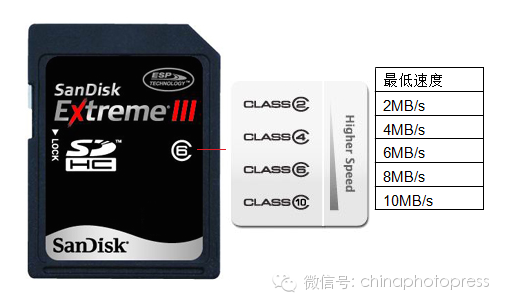The starting capacity of SDXC memory cards is typically above 64GB.

The speed class indicates the minimum storage speed of the memory card, not the maximum storage speed.
For memory cards, most people choose based on appearance and advertised speed, but to truly understand memory cards, one must first clarify what SD, SDHC, and SDXC are. SD stands for Secure Digital, which is the earliest SD card standard; SDHC stands for Secure Digital High Capacity; and SDXC stands for Secure Digital eXtended Capacity. These three types of memory cards have almost no difference in appearance and size and are supported by most digital SLR cameras. As for miniSD and microSD cards, they are not supported by digital SLR cameras (though they can be supported through an adapter) and also follow the aforementioned three memory card specifications, so they will not be discussed further here.
Differences Between SD, SDHC, and SDXC
In terms of quality and safety, there is no difference among SD, SDHC, and SDXC, and they are all referred to as SD cards. For general consumers and even professional users, the main difference among these three types of SD cards is capacity. The SD card, using the FAT16 file system, has a maximum capacity of 2GB, having evolved from the earliest 8MB and 16MB. The SDHC card, which follows the SD 2.0 standard, uses the FAT32 file system and has a capacity of 4GB-32GB. In other words, any SD card with a capacity over 2GB can be called an SDHC card; the SDXC card pushes the capacity up to a maximum of 2TB. Thus, it is evident that SD cards no longer meet the storage needs of current digital SLR cameras, especially when pixel counts exceed 20 million, as photos and HD videos demand higher storage capacities. SDHC cards are just right, offering higher capacity and meeting the current demands of digital SLR cameras for both capacity and speed, making them the most suitable choice for purchase. As for SDXC, while both capacity and speed are excellent, they are still too expensive for non-professional users.
The Significance of Speed Class
SDHC cards typically have markings of 2, 4, 6, and 10, indicating the minimum storage speed class, which represents the worst-case storage speed of the card. For example, if the minimum storage speed is 2MB/s, its speed class is 2 (Class 2); if the minimum speed is 10MB/s, then the speed class is 10. What is the significance of speed class? First, the write speed of the memory card is a measure of its performance. When storing photos in RAW format, differences in speed class can enhance the camera’s storage speed, allowing for faster continuous shooting without affecting the camera’s operation. Higher speed classes also accelerate read and write speeds between the camera, memory card, and computer. For videos, speed class is particularly important. The resolution and format of the video determine the stability of the data stream; to transfer video smoothly and without loss to the memory card, the minimum write speed of the card must match the required speed class. Otherwise, data loss and playback issues will occur during video storage. If a relatively advanced camera does not use a corresponding speed class memory card, such as a high-definition camera or a digital SLR set to HD mode, the device may alert the user that only lower-resolution video formats can be recorded.
The Significance of UHS
This is a technology that utilizes a new data bus to achieve high-speed storage, known as Ultra High Speed, which began to be officially applied to SDHC and SDXC cards in 2009. Its speed bandwidth can reach 104MB/s, with maximum speeds up to 300MB/s (for SDXC specifications). Note that UHS indicates the maximum speed of the memory card, which is different from the minimum speed class marking on SDHC cards and should not be generalized. It has significant advantages in high-resolution, high-bitrate HD video, supporting the storage of real-time video broadcasts, high-capacity HD video, and professional ultra-high-quality video, thus being widely used in professional digital SLR cameras and video equipment. In use, memory cards utilizing UHS technology require the device to also support this technology to function effectively; if placed in a camera that does not support this technology, it would be a significant waste. Currently, professional-grade SDHC and SDXC memory cards support this technology, such as the Nikon D810 and Sony A7R, which support this technology for digital SLR cameras with 36 million pixel levels.
China Photography News Brand Creates Value
Subscription postal code: 1-126, available at post offices nationwide
Postal customer service phone: 11185
